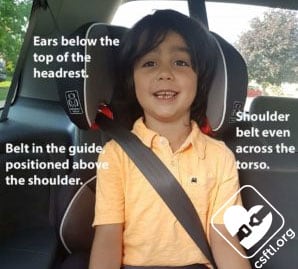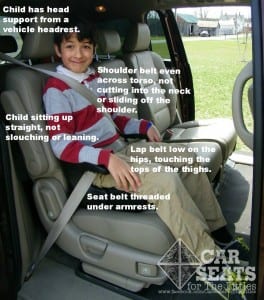When it comes to child passenger safety, best practice means making the safest choice, even when it’s the least convenient option. That translates to riding rear facing for as long as possible — ideally until the child is around 4 years old — then riding forward facing in a harnessed car seat until the child is at least 5 years old and mature enough to ride in a booster seat, then waiting as long as possible before moving your tween or teen out of a booster seat and into to the adult seat belt alone. In most cases, that switch goes smoothly — the child is old enough, weighs enough, is tall enough, and mature enough to make a switch. Moving a child to the next type of car seat or booster seat before they’re ready represents a compromise in safety that we’d like to discuss.
Best practice means waiting until the child meets the criteria before making that switch. Best practice is what we advocate for in everything we write and every conversation we have.
When we review combination car seats or booster seats that have a low minimum age for use in booster mode, we add the following note and link: CSFTL recommends that children be at least 5 years old before moving to a booster seat.
We also suggest that caregivers work with a CPST to help properly secure their child in their car seat or booster seat.
When we speak to manufacturers, we discuss best practice and these guidelines for transitions. Every time. We ask why some booster seats list a very low minimum age, and why some car seats that forward face list a low minimum weight, when best practice dictates that a delay in moving between these stages results in increased safety. We know that the advocates we work with are as committed to keeping children safe as we are and we keep bringing these points up. We’re seeing a slow change — an increase in minimum weight limits for booster seats and (slightly) higher minimum weights for forward facing in harnessed car seats. We applaud that change, but it’s not enough, so we’ll keep asking.
We know that we have an open door with many car seat manufacturers, and we use that door as much we are able to – always with the goal of creating changes that help more children ride safely. We also know that marketing is a powerful force in any company and there is almost always a disconnect between engineering, product teams, and marketing. It’s this disconnect that may lead some caregivers to make a choice based on marketing materials alone, rather than seek out the assistance of websites like ours or of a CPST in their community when it comes to seat selection or transition from one stage to the next.
While the 40 pound minimum weight for many booster seats serves the best practice model very well because it keeps younger children who aren’t ready for booster seats out of booster seats, one gray area we see a lot is children who weigh less than 40 pounds but are older than 5 years old. They may be mature enough for a booster seat but are too light to meet the minimum weight requirement. In most cases, we advise caregivers of the risks around moving that child to a booster seat and urge caregivers to keep that child in a harnessed car seat until the child meets the height, weight, and maturity criteria for transitioning to a booster seat.
The good news is that education around best practice is spreading. When our Editor’s daughter was 1, the year was 2007 and the kiddo weighed 18.5 pounds. Every single one of that kiddos’ peers was forward facing right around their 1st birthday. Research showed quite clearly that keeping her rear facing was the safest choice and yet, she was the only kid riding that way. At that time, children came out of car seats or booster seats when they were 6 years old or even younger!
Fast forward to today when many states have a law keeping children rear facing until they’re at least two. Many states have laws requiring the use of a car seat or booster seat until children are 8 years old or 4 foot 9, when they’d start to pass the Five Step Test. This is great, important, and life-saving progress.
The laws of physics remain the same but the laws of many states are starting to catch up. Along with those changes, marketing materials are starting to change as well. We’re seeing advertisements using older kids in booster seats, bigger toddlers riding rear facing, and older forward facing children riding in harnessed car seats.
We are also seeing a change that’s not as great: removing the age requirements on car seats and booster seats.
We’d prefer to see high minimum ages listed on all transitional car seats — on seats that forward face, and booster seats — so that caregivers know the bare minimum right time to make a transition. That’s why we add these disclaimers to many of our reviews: CSFTL advocates that children ride rear facing until the child outgrows their convertible seat rear facing, and is at least 2 years old and CSFTL recommends that children be at least 5 years old before moving to a booster seat.
We’d also like to see a federal standard around side impact protection. One has been in the works in the US for many years but it hasn’t been formally adopted yet.
Our best practice message is simple:
- Keep your child rear facing until at LEAST 2 years old, ideally until they outgrow their convertible car seat by weight or height.
- Keep your child in a forward facing harnessed car seat until they are at LEAST 5 years old and mature enough to sit properly in a booster seat.
- Keep your child in that booster seat until they’re at least 4 foot 9 and can pass the Five Step Test.
- Keep your child in the back seat of the vehicle until they’re at least 13 years old.
That way, your child can arrive safely and be the first ones to do everything else.
In all of our conversations with manufacturers’ Child Passenger Safety Advocates, they echo that same message. We’ve never seen our trusted friends, this small legion of CPSTs who have literally dedicated their working lives to keeping children safe, waver from that message.
We can talk about the past but we prefer to talk about two great things: the present and the future. Since our inception as an organization, we’ve seen dramatic changes in caregiver awareness around how willing caregivers are to learn about best practice. So we’ll never stop talking about it and we’ll never stop advocating for best practice.



